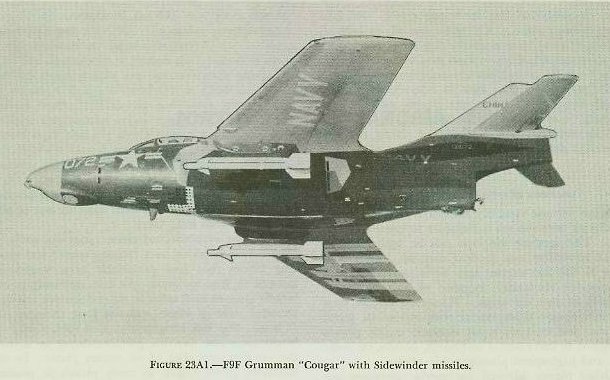| NAVAL ORDNANCE AND GUNNERY, VOLUME 2 CHAPTER 23 AIRCRAFT FIRE CONTROL |
| HOME INDEX Chapter 23 Aircraft fire control A. Introduction B. Aircraft gunnery C. Aircraft weapon systems D. Theory of horizontal bombing E. Other bombing problems F. Rocketry |
| AIRCRAFT FIRE CONTROL A. Introduction 23A1. Functions of aviation ordnance It has become virtually axiomatic that command of the air over the sea is requisite to control of the sea. The modern air arm can be utilized with great versatility and tactical surprise. In World War II the fast carrier task force proved itself a formidable contender, capable of gaining quick control of vast sea areas. Planes on fast carriers include fighter types armed with automatic guns, bombs, and rockets; night fighters; attack planes designed to carry aerial torpedoes, bombs, or rockets; and high-speed photographic planes. Other planes adapted for special purposes are also utilized by the modern Navy. Missions required of the naval air arm include destruction of enemy air arm, ships, personnel, transport, and installations; antisubmarine assignments associated with the activities of hunter-killer groups; spotting gunfire; patrol, search, and rescue duties; mine-laying; and transport of personnel and material. Aviation ordnance includes the weapons and ammunition that will ensure successful implementation of these missions. 23A2. History of aviation ordnance In 1910 a wooden platform was erected over the bow of a Navy ship, from which a test pilot took off successfully. Shortly thereafter, the same pilot took off from a land base, landed on another platform that had been rigged on the USS Pennsylvania, took off again, and returned to base. Thereafter, Navy training of pilots became a reality, but the Navy air arm was small at the outbreak of World War I; it grew rapidly during the war period, and the Bureau of Aeronautics was established in 1921. The Navy’s first carrier was the USS Langley, converted from a collier in 1922. Five years later the two carriers, the USS Lexington and the USS Saratoga, rebuilt on hulls originally intended for battle cruisers, joined the Fleet. Both of these aircraft carriers saw long and spectacular service. The Lexington succumbed to enemy attack in the battle of the Coral Sea, and the Saratoga lies at the bottom of Bikini Lagoon, having been sunk in one of the atom-bomb tests held there. Airplanes were assigned tactical missions early in World War I, taking over reconnaissance and spotting duties that had previously been vested in moored or free balloons. At first, opposing pilots largely ignored each other in air encounters, but this peaceful state of affairs was not long maintained. It is said that one imaginative pilot took a load of bricks aloft one day, his purpose being to shatter the wooden propeller of an enemy plane. In retaliation, pilots began to carry pistols as protection against such threats, and observers were soon armed with rifles. In such manner the development of aircraft armament had its origin. Small aerial bombs were used in the course of World War I. They were thrown from planes by pilots or observers, and were more effective from a morale standpoint than in terms of casualties produced or damage to enemy installations. In due course machine guns on free (flexible) mounts were installed in airplanes so located that a rear-seat observer could fire over the head of the pilot and the propeller arc. Then the German Fokker perfected a system wherein a fixed, forward-firing machine gun had a rate of fire so synchronized as to fire between blades of the propeller. The fixed, forward-firing gun quickly became a standard weapon, and has remained so to this day. The modern counterpart of the early free gun mount is the power-operated turret of a large bomber. In the interim between World War I and World War II, a variety of weapons were perfected for airborne use. During World War lithe military employment of such weapons was extended to include various automatic guns, torpedoes, bombs, ‘guided missiles, rockets, and mines. Thus the utility of the air arm was greatly broadened. But progress has brought added problems. Aviation ordnance and gunnery have always been closely associated with changes in aircraft design and performance. By the end of World War II, great advances had been made in flight speed and ability to operate at high altitude. These improvements in airplane performance have created additional problems concerning the design and employment of airborne weapons. Conversely, improvements in aviation ordnance have introduced problems of aircraft design. |
 |